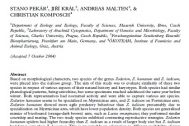Rok
2005Autoři
Christian Komposchdoc. RNDr. Jiří Král, Dr.
prof. Mgr. Stanislav Pekár, Ph.D.
Druhy
Zodarion italicum (Canestrini, 1868) ESObsah
Based on morphological characters, two species of the genus Zodarion, Z. hamatum and Zodarion italicum, were placed into the italicum group. The aim of this study was to evaluate similarity of these two species in respect of various aspects of their natural history and karyotypes. Both species had similar phenological patterns, being univoltine, but some specimens reached adulthood the same year before winter. Both representatives had nocturnal activity and were able to capture various ant species. Zodarion hamatum seems to be specialized on Myrmicinae ants, and Zodarion italicum on Formicinae ants. Zodarion hamatum showed more agile predatory behaviour than Zodarion italicum presumably due to specialization on Myrmicinae ants, which have lower population density. Both species are generalized mimics of bicoloured (orange-dark brown) ants, such as Lasius emarginatus
they performed similar courtship and mating. The two study species exhibited contrasting reproductive strategies. Zodarion hamatum spiders had higher fecundity than Zodarion italicum as a result of larger body size but Zodarion italicum had larger eggs than Z. hamatum. This is presumably an adaptation to different availability of prey ants. Both species had the same diploid chromosome number, sex chromosome system and pattern of X chromosome heteropycnosis in testes. Results support a very close relationship between these two Zodarion species.
they performed similar courtship and mating. The two study species exhibited contrasting reproductive strategies. Zodarion hamatum spiders had higher fecundity than Zodarion italicum as a result of larger body size but Zodarion italicum had larger eggs than Z. hamatum. This is presumably an adaptation to different availability of prey ants. Both species had the same diploid chromosome number, sex chromosome system and pattern of X chromosome heteropycnosis in testes. Results support a very close relationship between these two Zodarion species.
Citace
Pekár S., Král J., Malten A. & Komposch C. (2005): Comparison of natural histories and karyotypes of two closely related ant-eating spiders, Zodarion hamatumand Z. italicum (Araneae, Zodariidae). Journal of Natural History39: 1583–1596.



